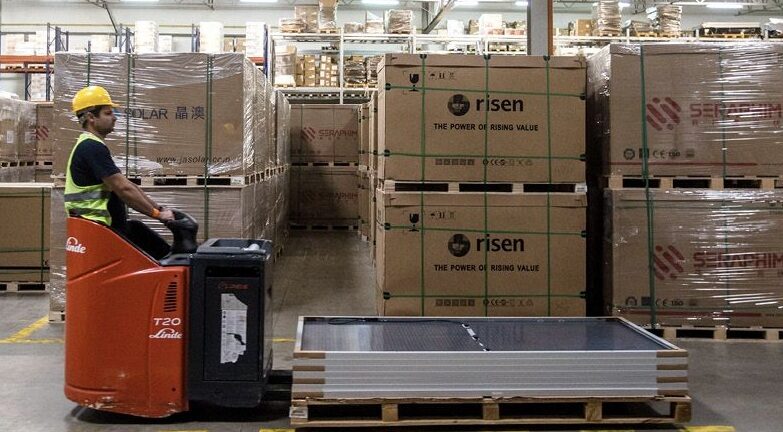From pv magazine USA
Solar projects can generally be placed in two buckets: they are either large utility-scale ground-mounted projects connected to the grid, or they are smaller, distributed projects, typically 20 MW in capacity or less.
In California, and many other U.S. states, smaller, distributed projects, particularly ones located behind the meter, are under attack from utilities and state legislatures, often being scapegoated for high electricity rates. A paper by Mark Jacobson, professor of civil and environmental engineering at Stanford University, explains why we should be supporting behind-the-meter solar installations nationwide.
Distributed, small-scale solar projects are often classified as either behind-the-meter (BTM), or front-of-the-meter (FOM), depending on how they are connected to the grid.
FOM systems are connected to grid distribution lines, they serve buildings directly, minimizing the need for building additional transmission lines. Distribution lines are connected to transmission lines, so FOM solar can also feed its electricity to the transmission system. They are, therefore, subject to the same market and grid connection rules as utility PV systems.
Behind-the-meter systems are typically smaller than FOM systems, and are often installed on buildings, over parking lots, hillsides, yards, and vacant lots that service buildings directly. Any excess electricity production from these systems can be sent back to the grid, and if the system does not meet 100% of demand, it can draw power from the grid.
“Grid operators generally oppose BTM distributed PV because its first impact is to reduce demand for grid electricity,” said Jacobson. “Utilities claim that the remaining customers must pay a higher cost for the remaining demand, mostly because the fixed cost of the transmission and distribution system is now spread over fewer customers.”
Jacobson offered ten reasons why BTM solar helps everyone:
1. The claim that BTM solar reduces electricity demand and therefore increases costs by spreading the fixed cost of transmission and distribution over fewer customers, known as the “cost shift,” ignores the reality of the energy transition. Buildings, transportation, and industry are all being electrified. Jacobson said electricity needs will nearly double.
“Even if 25 percent of the total electricity demand is met with BTM PV, overall grid electricity needs will still increase by 50 percent compared with today. Thus, the assumption by utilities that a large growth in BTM PV reduces demand holds true only for low levels of electrification, not for large-scale electrification, which is needed to address climate, pollution, and energy security problems,” said Jacobson.
2. BTM rooftop solar requires no new land, whereas utility-scale does. Therefore, BTM solar reduces land requirements and habitat damage.
3. BTM solar reduces the need for transmission and distribution lines. Grid customers need transmission and distribution lines for 100 percent of their electricity consumption, and utility PV requires transmission and distribution lines for 100 percent of its generation. BTM solar customers only need transmission lines that support the extra demand not met by their solar array.
4. When BTM solar co-located with a battery produces more than the building consumes, excess electricity is sent back to the grid. This is helpful in avoiding blackouts, particularly on hot summer days in regions where AC is used.
5. Transmission line sparks have led to devastating wildfires, such as in California and Hawaii. The cost of such fires and undergrounding transmission lines due to the fires have been passed down to customers in California. BTM solar reduces fire occurrences, said Jacobson.
6. The addition of BTM PV reduces the mining, processing, and burning of polluting fuels (fossil fuels and bioenergy) for electricity generation on the grid, thereby supporting a cleaner environment.
7. By reducing greenhouse gas emissions from polluting fuels, BTM PV reduces climate damage to both distributed PV and grid customers.
8. By reducing the use of fossil fuels, BTM PV reduces energy insecurity problems associated with fossil fuels.
9. Installing BTM PV creates more jobs than installing and running utility PV and other grid-scale electricity generation, and this benefits a state or country as a whole.
10. Because rooftop PV absorbs 20% to 26% of the sunlight that hits it, then converts the light to electricity, less light is absorbed by the building, cooling the building during the day and reducing daytime electricity demand for air conditioning. Such cooling is greatest during summer and during the day, when electricity prices are highest.
Jacobson offered a few more reasons why behind-the-meter solar is a benefit to ratepayers at large, which can be read here.
This content is protected by copyright and may not be reused. If you want to cooperate with us and would like to reuse some of our content, please contact: editors@pv-magazine.com.




By submitting this form you agree to pv magazine using your data for the purposes of publishing your comment.
Your personal data will only be disclosed or otherwise transmitted to third parties for the purposes of spam filtering or if this is necessary for technical maintenance of the website. Any other transfer to third parties will not take place unless this is justified on the basis of applicable data protection regulations or if pv magazine is legally obliged to do so.
You may revoke this consent at any time with effect for the future, in which case your personal data will be deleted immediately. Otherwise, your data will be deleted if pv magazine has processed your request or the purpose of data storage is fulfilled.
Further information on data privacy can be found in our Data Protection Policy.